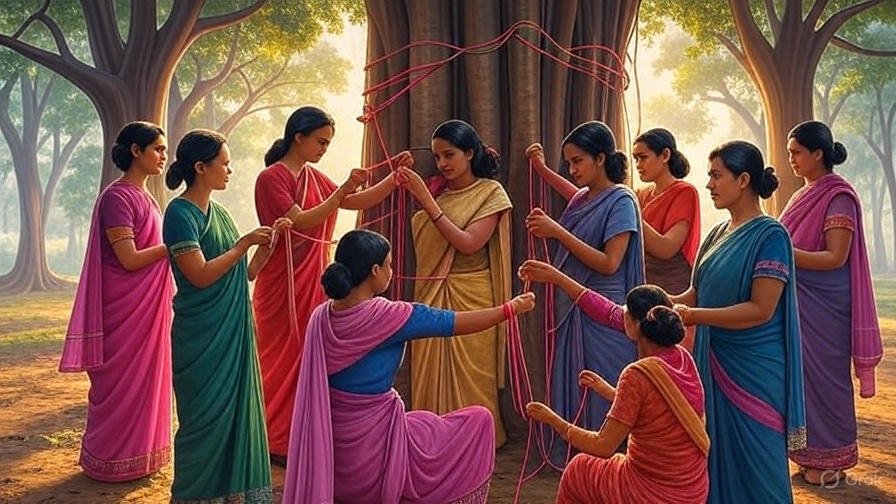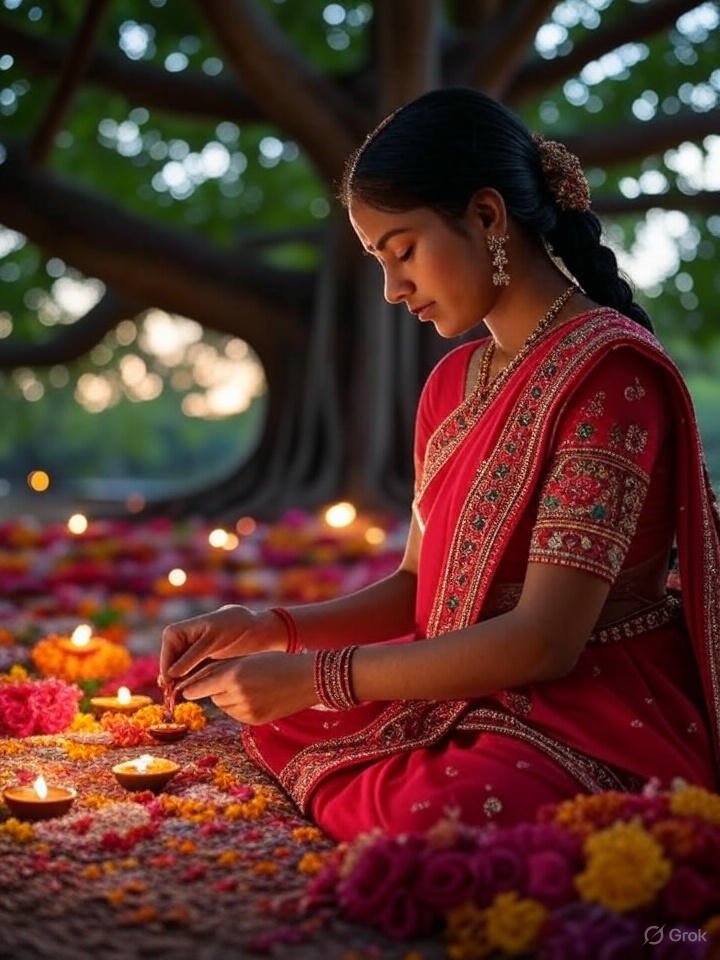The Vat Savitri Vrat Katha is a revered Hindu fasting ritual observed by married women to pray for the longevity and prosperity of their husbands. Rooted in the legendary tale of Savitri and Satyavan, this vrat symbolizes unwavering devotion, marital fidelity, and the power of a woman’s resolve. Celebrated on the Amavasya (new moon) or Purnima (full moon) in the Hindu month of Jyeshtha (May–June), the festival revolves around worshipping the Vat (banyan) tree, which holds deep spiritual and mythological significance.
In this comprehensive guide, we delve into the Vat Savitri Vrat Katha, its rituals, significance, and how to observe the fast. Whether you’re a devotee seeking to reconnect with tradition or a curious reader exploring Hindu culture, this blog offers everything you need to know.
Why is Vat Savitri Vrat Observed?

The Vat Savitri Vrat is inspired by the legend of Savitri and Satyavan from the Mahabharata. Savitri, a devoted wife, used her wit and devotion to challenge Yama (the God of Death) and reclaim her husband’s life. The banyan tree is central to this story, symbolizing immortality and the cyclical nature of life.
Key Significance:
- Marital Harmony: Women pray for their husbands’ health and long life.
- Spiritual Strength: The fast embodies the power of penance and faith.
- Cultural Legacy: The ritual preserves ancient traditions tied to nature worship.
The Legend of Vat Savitri Vrat Katha
Image Prompt 3: A classical art depiction of Savitri confronting Yama, with Satyavan lying unconscious under a banyan tree.
The Vat Savitri Katha is a timeless narrative of love conquering death. Here’s the full story:
Savitri’s Choice
Princess Savitri, known for her beauty and wisdom, chose to marry Satyavan, a prince cursed to die within a year. Despite warnings from Sage Narada, she married him and moved to the forest.
The Day of Destiny
On the predicted day of Satyavan’s death, he collapsed under a banyan tree while cutting wood. Yama arrived to claim his soul, but Savitri followed him, pleading for her husband’s life.
Savitri’s Triumph
Through her relentless discourse and devotion, Savitri impressed Yama. He granted her three boons, reviving Satyavan and blessing her with prosperity and children.
Image Prompt 4: Savitri and Satyavan reunited under the banyan tree, symbolizing love’s victory over death.
This story underscores the ideals of pativrata dharma (a wife’s devotion) and the belief that true love can defy fate.
Rituals of Vat Savitri Vrat: A Step-by-Step Guide
Image Prompt 5: A puja thali with fruits, flowers, sacred thread, rice, and diya arranged for Vat Savitri Vrat.
Preparations:
- Pre-Dawn Bath: Women wake early, purify themselves with a bath, and wear new clothes (preferably red or yellow).
- Fasting: A strict nirjala (without water) or phalahar (fruit-based) fast is observed.
Puja Process:
- Worship the Banyan Tree:
- Circle the tree 7/108 times, tying raw cotton threads around its trunk.
- Offer flowers, rice, water, and sweets.
- Recite the Katha: The story of Savitri is narrated to invoke blessings.
- Pray for Blessings: Seek longevity for husbands and family unity.
Image Prompt 6: Women exchanging gifts and sharing meals after completing the Vat Savitri Vrat Katha rituals.
Post-Puja Rituals:
- Distribute prasad (offerings) to family and friends.
- Break the fast after sunset by consuming fruits and sattvic food.
Dates and Regional Variations
In 2024, Vat Savitri Vrat will be observed on June 6 (North India) and June 21 (South India). Regional customs differ:
- North India: Focus on the banyan tree and Savitri’s story.
- Maharashtra: Women tie threads around a peepal or banyan tree.
- Odisha: Known as Sabitri Brata, with unique folk songs.
Why the Banyan Tree?
Image Prompt 7: A majestic banyan tree with aerial roots, symbolizing eternal life and strength.
The banyan tree (Ficus benghalensis) is revered in Hinduism as the Kalpa Vriksha (wish-fulfilling tree). Its ever-expanding roots and longevity mirror Savitri’s eternal love and the cycle of life and death.
Benefits of Observing Vat Savitri Vrat
- Strengthens marital bonds.
- Enhances spiritual discipline.
- Invokes divine protection and prosperity.
External Links for Deeper Insight:
- The Mahabharata’s Savitri-Satyavan Episode
- Significance of Banyan Trees in Hinduism
- Guide to Hindu Fasting Rituals
FAQs About Vat Savitri Vrat
Q: Can unmarried women observe this fast?
A: Yes, unmarried women may observe it for a virtuous life partner.
Q: What if I cannot find a banyan tree?
A: Use a potted banyan sapling or a sacred thread as a symbolic substitute.
Q: Is the fast observed for one or three days?
A: Most regions follow a one-day fast, but some communities observe it for three days.
Conclusion: Embrace the Legacy of Savitri
Image Prompt 8: A family celebrating Vat Savitri Vrat together, symbolizing unity and cultural pride.
The Vat Savitri Vrat Katha is more than a ritual—it’s a celebration of love’s resilience and womanhood’s strength. By observing this vrat, women honor Savitri’s legacy while fostering spiritual growth and familial harmony.
Whether you’re narrating the katha to younger generations or performing the puja with devotion, let this festival remind you that faith and determination can transcend even death.








